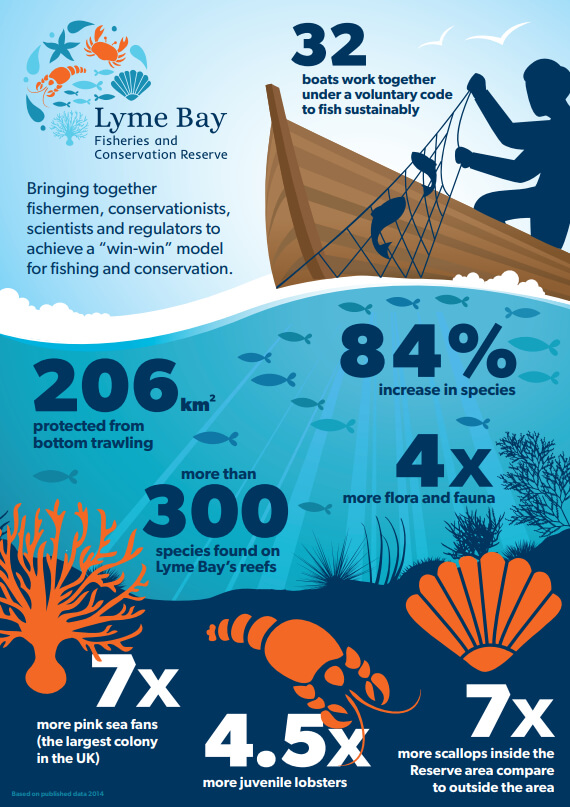It’s difficult to be optimistic when faced with endless reports of overfishing, pollution and rising sea temperatures. For a change, here is a success story: the Lyme Bay marine protected area.

The problem
Back in 1988 scientists identified that the marine life in Lyme Bay was of international importance – the reefs providing a habitat to rare species of coral, sponges and sea fans, as well as diverse fish and shellfish populations. Unfortunately, this fragile ecosystem was being destroyed by scallop dredgers which effectively plough the seabed to leave it desert-like, devoid of life.
Formation of the reserve
Environmental groups began to get involved, assessing the damage, and by 2001 some fishermen had agreed not to fish two areas of reef – Lanes Ground and Saw Tooth Ledges. However, due to a surge in the scallop prices and rising fuel costs, the agreement had broken down by 2006.
In 2008, after a lot of bureaucracy between endless acronymed organisations, 60 square nautical miles was closed to scallop dredgers and bottom trawls. This was the largest marine protected area in British waters ever to be protected. In 2010 it was increased to 90 square miles which remains the largest marine protected area in British waters today.


Sustainable fishing
Sustainable fishing is fishing that can be maintained in the future, considering not just the environment, but also social and economic aspects. These three aspects are inextricably linked, and therefore must be considered holistically.
The creation of the protected area in Lyme Bay was just the beginning. The management of the reserve into the future is what will determine its effectiveness. Banning fishing practices like scallop dredging and bottom trawling certainly benefit the marine environment, but what about the social and economic effects? Income from fishing supports the coastal communities around Lyme Bay and gives the villages their rich cultural history which attracts tourists and has merit to be preserved in its own right.
One may think that it’s in the best interests of the fishermen to stop fishing unsustainably since otherwise, they’ll be nothing left to catch. Many fishermen understand this and are open to cooperation. However, others are close to retirement and have little concern for the next generation. The marine protected area is an inconvenience and threatens their financial security. They’re set in their ways and don’t want to be told to change, especially by an environmentalist who doesn’t appreciate just how tough it is to make a living from fishing. Perhaps they have no hope – they believe it’s too late to save the seas.
These attitudes pose a challenge to conservationists, and for the fishing industry to cooperate with marine conservation, initiatives must be taken that support the industry. Communication is clearly vital, but fishermen are not often involved in decision making, leading to distrust and animosity towards conservationists. In 2011, BLUE Marine Foundation took the unconventional step of creating a working group that brought together fishermen, conservationists, researchers and regulators to make decisions concerning the management of the reserve together. Once the stakeholders listened to each other, they found common ground and developed a win-win model that benefits both the fishermen and the marine environment.


A code of conduct was written that ensures fishing is within sustainable limits. Since it’s voluntary, it avoids the bureaucracy of statutory law which allowed it to be implemented quickly and makes it more flexible to changes in the future.
Fishermen use sustainable, low impact methods of fishing such as pots, static nets, or rod and line. The code requires boats to be fitted with GPS tracking devices to monitor where fishing occurs and so that the fish caught is fully traceable. Furthermore, there are restrictions on the number of pots and the length of nets that a fisherman can use and lobster pots must be fitted with escape hatches that allow undersize lobsters to escape.
To market the sustainable, high quality, provenance-assured catch of fishermen, the Reserve Seafood brand was created. People who care about the environment are happy to pay higher prices for fish they can eat with a clear conscience, even if that means eating fish less often.
In addition, efforts have been made to ensure seafood is sold at the highest quality. Chiller units and ice machines were installed on the quayside at Axemouth, Lyme Regis and West Bay and a van funded by BLUE takes fish directly from quayside to market.
Studies have shown that the fishermen earn more for less and are more satisfied with life.
Benefits for the environment

Plymouth University has been studying the recovery of Lyme Bay since the MPA was created, and over 20 scientific papers have been published. So what are their findings?
Long term monitoring of the seabed using underwater cameras has shown remarkable recovery of marine life since scallop dredgers and bottom trawlers were banned. This includes not just marine habitats and rare species, but also commercially important stocks, thus benefitting the fishing industry.
References
https://www.lymebayreserve.co.uk
https://www.bluemarinefoundation.com/projects/lyme-bay/
http://www.dorsetmpas.uk/lyme-bay-reefs/
https://theecologist.org/2017/feb/02/governing-marine-protected-areas-lyme-bay
https://bluecharter.thecommonwealth.org/lyme-bay-fisheries-conservation-reserve-uk-on-going/

Leave a Reply